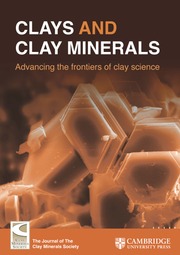Crossref Citations
This article has been cited by the following publications. This list is generated based on data provided by
Crossref.
Fiore, S.
Huertas, F. J.
Huertas, F.
and
Linares, J.
2001.
Smectite formation in rhyolitic obsidian as inferred by microscopic (SEM-TEM-AEM) investigation.
Clay Minerals,
Vol. 36,
Issue. 4,
p.
489.
Frost, Ray L.
Kloprogge, J.Theo
and
Ding, Zhe
2002.
The Garfield and Uley nontronites—an infrared spectroscopic comparison.
Spectrochimica Acta Part A: Molecular and Biomolecular Spectroscopy,
Vol. 58,
Issue. 9,
p.
1881.
Gates, W. P.
Slade, P. G.
Manceau, A.
and
Lanson, B.
2002.
Site Occupancies by Iron in Nontronites.
Clays and Clay Minerals,
Vol. 50,
Issue. 2,
p.
223.
Ding, Z.
and
Frost, R.L.
2002.
Controlled rate thermal analysis of nontronite.
Thermochimica Acta,
Vol. 389,
Issue. 1-2,
p.
185.
Vogt, Christoph
Lauterjung, Jörn
and
Fischer, Reinhard X.
2002.
Investigation of the Clay Fraction (<2 µm) of the Clay Minerals Society Reference Clays.
Clays and Clay Minerals,
Vol. 50,
Issue. 3,
p.
388.
Kim, Jin-wook
Furukawa, Yoko
Daulton, Tyrone L.
Lavoie, Dawn
and
Newell, Steven W.
2003.
Characterization of Microbially Fe(III)-Reduced Nontronite: Environmental Cell-Transmission Electron Microscopy Study.
Clays and Clay Minerals,
Vol. 51,
Issue. 4,
p.
382.
Kim, Jinwook
Dong, Hailiang
Seabaugh, Jennifer
Newell, Steven W.
and
Eberl, Dennis D.
2004.
Role of Microbes in the Smectite-to-Illite Reaction.
Science,
Vol. 303,
Issue. 5659,
p.
830.
Li, Yi-Liang
Vali, Hojatollah
Sears, S.Kelly
Yang, John
Deng, Baolin
and
Zhang, Chuanlun L
2004.
Iron reduction and alteration of nontronite NAu-2 by a sulfate-reducing bacterium.
Geochimica et Cosmochimica Acta,
Vol. 68,
Issue. 15,
p.
3251.
Fernández-Caliani, J. C.
Crespo, E.
Rodas, M.
Barrenechea, J. F.
and
Luque, F. J.
2004.
Formation of Nontronite from Oxidative Dissolution of Pyrite Disseminated in Precambrian Felsic Metavolcanics of the Southern Iberian Massif (Spain).
Clays and Clay Minerals,
Vol. 52,
Issue. 1,
p.
106.
Hradil, David
Grygar, Tomáš
Hrušková, Michaela
Bezdička, Petr
Lang, Kamil
Schneeweiss, Oldřich
and
Chvátal, Marek
2004.
Green Earth Pigment from the Kadaň Region, Czech Republic: Use of Rare Fe-rich Smectite.
Clays and Clay Minerals,
Vol. 52,
Issue. 6,
p.
767.
Gaudin, A.
Grauby, O.
Noack, Y.
Decarreau, A.
and
Petit, S.
2004.
Accurate crystal chemistry of ferric smectites from the lateritic nickel ore of Murrin Murrin (Western Australia). I. XRD and multi-scale chemical approaches.
Clay Minerals,
Vol. 39,
Issue. 3,
p.
301.
Kim, Jin-Wook
Furukawa, Yoko
Dong, Hailiang
and
Newell, Steven W.
2005.
The Effect of Microbial Fe(III) Reduction on Smectite Flocculation.
Clays and Clay Minerals,
Vol. 53,
Issue. 6,
p.
572.
Michalski, Joseph R.
Kraft, Michael D.
Sharp, Thomas G.
Williams, Lynda B.
and
Christensen, Philip R.
2005.
Mineralogical constraints on the high-silica martian surface component observed by TES.
Icarus,
Vol. 174,
Issue. 1,
p.
161.
Jaisi, Deb P.
Kukkadapu, Ravi K.
Eberl, Dennis D.
and
Dong, Hailiang
2005.
Control of Fe(III) site occupancy on the rate and extent of microbial reduction of Fe(III) in nontronite.
Geochimica et Cosmochimica Acta,
Vol. 69,
Issue. 23,
p.
5429.
Slowey, Aaron J.
Rytuba, James J.
and
Brown, Gordon E.
2005.
Speciation of Mercury and Mode of Transport from Placer Gold Mine Tailings.
Environmental Science & Technology,
Vol. 39,
Issue. 6,
p.
1547.
O'Reilly, S Erin
Watkins, Janet
and
Furukawa, Yoko
2005.
Secondary mineral formation associated with respiration of nontronite, NAu-1 by iron reducing bacteria.
Geochemical Transactions,
Vol. 6,
Issue. 4,
Michot, Laurent J.
Bihannic, Isabelle
Maddi, Solange
Funari, Sérgio S.
Baravian, Christophe
Levitz, Pierre
and
Davidson, Patrick
2006.
Liquid–crystalline aqueous clay suspensions.
Proceedings of the National Academy of Sciences,
Vol. 103,
Issue. 44,
p.
16101.
Stucki, J.W.
2006.
Handbook of Clay Science.
Vol. 1,
Issue. ,
p.
423.
Michalski, Joseph R.
Kraft, Michael D.
Sharp, Thomas G.
Williams, Lynda B.
and
Christensen, Philip R.
2006.
Emission spectroscopy of clay minerals and evidence for poorly crystalline aluminosilicates on Mars from Thermal Emission Spectrometer data.
Journal of Geophysical Research: Planets,
Vol. 111,
Issue. E3,
O'Reilly, S.E.
Furukawa, Yoko
and
Newell, Steven
2006.
Dissolution and microbial Fe(III) reduction of nontronite (NAu-1).
Chemical Geology,
Vol. 235,
Issue. 1-2,
p.
1.

